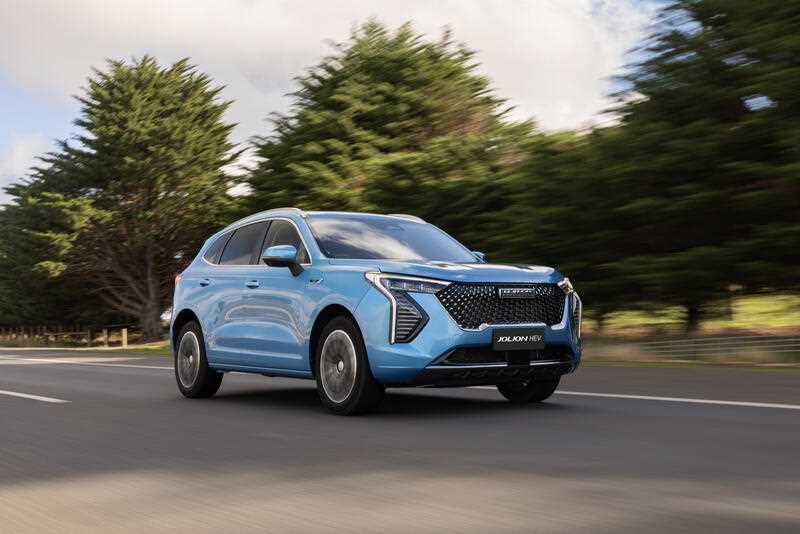Over the years there have been some interesting names for cars.
Here’s the latest. The Jolion.
The what?
Yes, Jolion.
Or for completeness, the Great Wall Motors Haval Jolion Ultra Hybrid.
It must surely be the most oddly-named vehicle to reach Australia since the very first Toyota Kluger – which sounded more like a cooking implement.
Like the Kluger, the Jolion has instantly found an audience for its sensible design, strong technology features and impressive build and finish.
Having previously named its models numerically (the H4 and H6), Chinese maker Haval went down a different path with the Jolion. Nobody is quite sure why.
Haval is part of Great Wall Motors (there’s a name with some staying power) and, as is the case with most models that have joined this ever-growing Chinese influx, it’s available at a bargain price (the entry-level Jolion costs $28,490).
Tested here is the Ultimate Jolion – literally – bringing the full technology and luxury package to the market for an enticing $40,990 drive away. It’s also the first hybrid Haval model to reach these shores.
Haval is soon to celebrate its 10th anniversary in Australia and the Jolion is living proof of the progress the company (and most Chinese makers) has made in that time.
The four-cylinder Jolion resides towards the bottom of the Haval range (rival MG has snapped up most of the value buyers in the sub-$20k category) but with its clean lines, relatively plush interior and civilised road manners, it’s already enjoying popularity in Australia.
The addition of a fuel-saving, performance-enhancing hybrid drivetrain will attract even more new buyers to the brand, even if only the flagship model provides access to it.
And there’s no need to feel shy or self-conscious driving the Jolion. It’s a stylish-looking thing inside and out, provides decent performance and is unquestionably comfortable.
Its hybrid powertrain, a 1.5-litre, four-cylinder 110kW engine boosted by an electric motor, drives the front wheels to deliver a combined 180kW.
While its design isn’t strictly cutting edge, the Jolion is inoffensive and creators happily didn’t get too radical.
Yes, the front end styling is bold, thanks to an oversized chrome grille which stops just short of being excessive.
Likewise the presentation of the cockpit, which delivers a relatively up-market look with sweeping curves and soft-touch surfaces. Virtually every amenity is channelled through the generously-sized touch-screen display which dominates the dash and centre stack.
There’s a smaller screen which replaces the traditional instrument panel which is useful but a little clunky to use. There was no luck finding a trip meter, despite half an hour looking.
The Jolion features a rotary-style gear selector that’s favoured by a growing number of brands, although in the Haval was a touch temperamental and required two or three attempts to change direction sometimes.
While there’s plenty to like about the Jolion, there were a couple of fairly significant gripes.
On the open road it is generally well behaved. It is a little noisy over rough surfaces, and the petrol/hybrid combination delivers more than adequate performance while sipping a miserly 5L/100km.
The electronic safety suite is comprehensive, particularly for a car in this price bracket. But there’s nothing subtle about how it performs. The lane-keeping assist, for instance, did its best to wrestle the steering wheel away from the driver every time the car crossed an unbroken line, or otherwise pinballing from lane-marker to lane-market on either side of the lane.
More disturbing was the active cruise control, which was very nervous in surrounding freeway traffic but even worse when it spotted a concrete lane barrier, causing it to slow dramatically to avoid running into something that wasn’t there.
Think about braking at 110km/h highway speeds (with a large truck in the rear vision mirror), by way of comparison.
Inside the electronics perform better, but not perfectly, via two glossy touch-screens as has become industry standard. The main 12.3-inch digital panel was easy enough to navigate and the touch-screen generally managed to cope with the regular commands put through it, although some of the protocols are a bit clunky.
For instance changing climate control settings required two or three good stabs with the finger before the correct function was reached. And don’t waste time looking for digital radio – there is none.
None of this (except perhaps the cruise control) should prevent buying the Jolion.
It’s well equipped, nicely built and represents outstanding value for money, silly name or not.
HAVAL JOLION ULTRA HYBRID
* HOW BIG? It’s a small SUV but delivers impressive space for occupants and a decent 370 litres for cargo.
* HOW FAST? With a total of 180kW on tap, it accelerates more quickly than most might imagine and lopes along effortlessly on the open road.
* HOW THIRSTY? Official thirst is 5L/100km which is excellent in any language.
* HOW MUCH? The Jolion range starts at $28,490. The flagship model is good buying at a tick over 40 grand, drive away.
By Peter Atkinson in Brisbane



